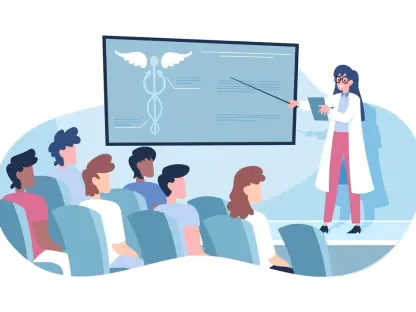In a landscape where healthcare costs are soaring and chronic conditions like obesity and type 2 diabetes continue to burden millions, the United States has placed a massive financial wager on GLP-1 receptor agonists, a class of medications heralded for their potential to transform metabolic health. With investments reaching into the tens of billions of dollars, drugs like Wegovy and Zepbound have emerged as powerful tools in combating weight-related challenges. However, the promise of these treatments is clouded by a critical issue: not every patient responds to them in the same way. Some experience life-changing results, while others face disappointment with minimal outcomes despite significant expense. This variability raises a pressing concern within the healthcare system about how to ensure that such a substantial investment delivers meaningful returns. Tailoring these therapies to individual needs could be the key to maximizing their impact and avoiding wasted resources.
The Promise and Challenge of GLP-1 Therapies
The rise of GLP-1 receptor agonists has sparked hope among healthcare providers and patients alike, offering a new frontier in managing obesity and related metabolic disorders. These medications work by mimicking a hormone that regulates appetite and blood sugar, often leading to significant weight loss and improved health markers for many users. Their potential to address a public health crisis is undeniable, as obesity rates remain stubbornly high across the nation. Pharmaceutical advancements have positioned these drugs as a cornerstone of modern treatment plans, with widespread adoption fueled by clinical success stories. Yet, beneath the surface of this optimism lies a complex reality. The financial commitment to these therapies is staggering, and the expectation of universal efficacy has not been met. Variability in patient outcomes suggests that a deeper understanding of how these drugs interact with individual biology is essential to justify their cost and ensure equitable benefits.
Beyond the initial excitement, the challenge of inconsistent results with GLP-1 drugs reveals a gap in the current approach to treatment. Clinical observations indicate that while some patients achieve dramatic weight loss, others hit a plateau after modest gains or see no improvement at all. This disparity is not merely anecdotal; it reflects a broader issue of biological, behavioral, and environmental factors influencing how each person metabolizes and responds to the medication. Without mechanisms to identify why certain individuals benefit more than others, the healthcare system risks overspending on therapies that fail to deliver for a significant portion of patients. The lack of tailored strategies means that resources are often allocated inefficiently, leaving both patients and providers frustrated. Addressing this variability requires a shift in focus toward understanding the unique factors at play for each individual, paving the way for more effective and sustainable use of these powerful drugs.
Cost-Effectiveness Concerns in GLP-1 Deployment
The economic implications of widespread GLP-1 use are a growing concern, as the high cost of these medications raises questions about their long-term viability within the healthcare budget. Studies from leading institutions suggest that for drugs like Wegovy to be considered cost-effective solely for weight loss, their price would need to drop by over 80%, while Zepbound would require a reduction of about one-third. This stark analysis underscores the disconnect between current pricing models and the average health benefits observed across patient populations. When outcomes vary so widely, justifying such expenses becomes increasingly difficult, especially for those who derive little to no benefit from treatment. Policymakers and insurers are thus faced with the challenge of balancing access to innovative therapies with fiscal responsibility, ensuring that investments align with tangible improvements in public health.
Delving deeper into the cost-effectiveness dilemma, the concept of “average” benefits fails to capture the diverse experiences of patients using GLP-1 drugs. Relying on generalized data overlooks the reality that some individuals achieve transformative results, while others incur high costs for negligible gains. This mismatch highlights the need for a more nuanced evaluation of value, one that accounts for individual response patterns rather than broad statistics. Without such an approach, the risk of overprescribing or continuing ineffective treatments grows, straining both patient finances and systemic resources. A targeted strategy that identifies who stands to gain the most from these therapies could help redirect funds toward those likely to benefit, while exploring alternative solutions for others. This shift in perspective is crucial to ensuring that the billions spent on GLP-1 drugs translate into measurable, equitable health outcomes across the board.
Personalization as the Path Forward
The diversity of patient responses to GLP-1 therapies has led to a clear categorization of outcomes, often dividing users into super-responders, general responders, and non-responders based on weight loss metrics. Super-responders experience remarkable success, shedding at least 10% of their body weight during treatment, while general responders see moderate effects, typically losing between 5% and 10% within a few months. Non-responders, however, show minimal progress, often losing less than 5% before plateauing, despite ongoing costs and efforts. This spectrum of results emphasizes that a uniform prescribing model is insufficient to address the needs of all patients. Recognizing these distinct groups is a critical step toward developing personalized treatment plans that optimize outcomes by matching therapy to individual profiles, rather than applying a blanket approach that leaves many underserved.
Moving beyond categorization, the healthcare system must establish systematic methods to monitor and adapt GLP-1 treatments based on real-time patient responses. Currently, there is no scalable framework to track effectiveness over time, meaning many individuals continue using medications without improvement or switch brands with little success. This gap places an unfair burden on patients to navigate outcomes and expenses without adequate guidance. Implementing persistent response monitoring could transform this landscape, enabling providers to adjust dosages, switch therapies, or explore complementary interventions as needed. Such a data-driven approach would ensure that the significant financial investment in GLP-1 drugs yields meaningful results, rather than becoming a gamble with uncertain returns. By prioritizing personalization, the system can better serve those with metabolic conditions, turning potential into progress for the greatest number of people possible.
Building a Future of Tailored Metabolic Care
Reflecting on the journey of GLP-1 therapies, it has become evident that past efforts to integrate these drugs into mainstream care often overlooked the critical factor of individual variability. Initial enthusiasm led to widespread adoption, but the absence of tailored monitoring meant that many patients continued treatments without success, while others who could have benefited more were not adequately supported. The systemic shortcomings in tracking and adapting to patient responses were a missed opportunity to align costs with outcomes. Historical pricing models, too, relied on generalized assumptions that failed to reflect the true diversity of experiences. These challenges underscored the importance of learning from earlier missteps to build a more responsive framework for managing metabolic health treatments.
Looking ahead, the next steps involve a concerted effort to embed personalization into every facet of GLP-1 therapy deployment. Developing robust systems for ongoing response evaluation should be a priority, allowing healthcare providers to make informed decisions about continuing or adjusting treatments. Collaboration between researchers, clinicians, and policymakers can drive the creation of tools and protocols that identify super-responders early and support others with alternative strategies. Additionally, addressing cost barriers through innovative pricing models tied to individual outcomes could ensure broader access without compromising fiscal sustainability. By focusing on these actionable measures, the healthcare system can transform the substantial investment in GLP-1 drugs into a catalyst for lasting, equitable health improvements, setting a precedent for personalized care in other therapeutic areas as well.









